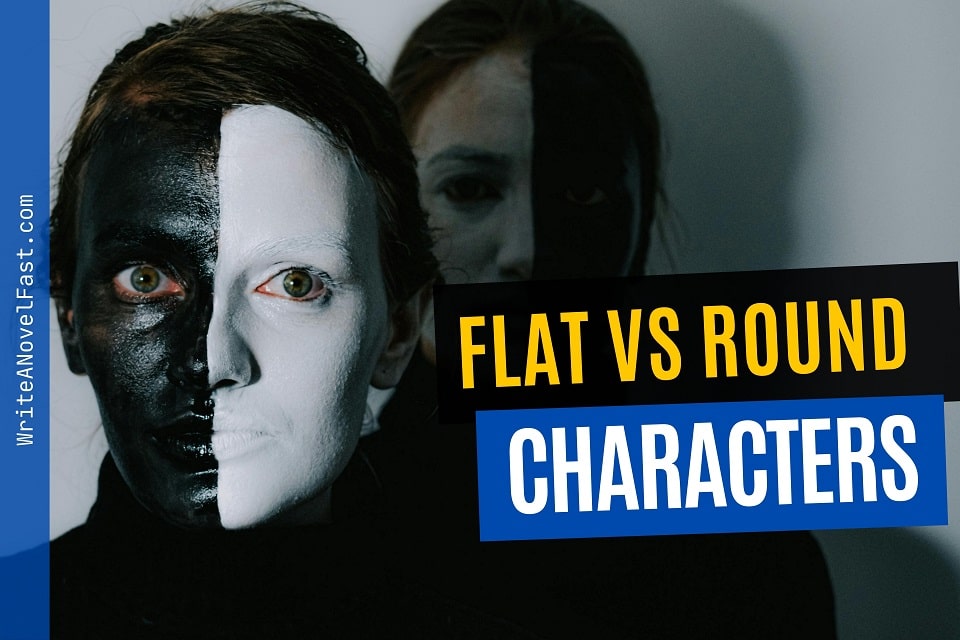Let’s be honest—when we fall in love with a story, it’s usually because of the characters. Not just what they do, but who they are. Maybe they made us laugh, cry, or scream into a pillow at 2 a.m. Whatever it is, they felt real. But not every character needs to be deep or complicated. Sometimes, they’re simple and still serve a purpose. That’s where the classic writing concept of flat vs round characters comes in.
In this guide, you’ll find flat vs round characters explained in a way that makes sense (without sounding like a dusty textbook). Whether you’re a writer crafting your next novel or a reader who’s curious about the magic behind character design, let’s explore how these two types play essential roles in storytelling.
Table of content:
What Are Flat Characters, Really?
Flat characters are like background actors in a movie—you remember them, but you don’t always know much about them. They’re often one-note and defined by a single trait. Think of them as puzzle pieces that help complete the scene but aren’t the entire picture.
Take Mr. Filch from Harry Potter. He’s cranky, obsessed with his cat, and kind of creepy. That’s about it. And honestly? That’s all he needs to be. He adds flavor to the Hogwarts world without needing a full emotional backstory.
Flat characters often get a bad rap, but they’re not “bad” writing. They can be funny, functional, or even emotionally impactful when used well. In a sea of emotionally complex characters, a flat character can provide contrast, comic relief, or even stability.
Round Characters: Where the Heart Lives
Now, on the flip side, round characters are the ones who breathe life into the story. They’ve got layers, conflicts, backstories, growth—you name it. These are the characters who change, make tough choices, and carry the emotional weight of the narrative.
Think Elizabeth Bennet from Pride and Prejudice. She’s witty and charming, sure. But she also wrestles with pride, misjudgment, societal pressure, and her evolving feelings for Mr. Darcy. She grows. She learns. She surprises us.
In this context of flat vs round characters explained, think of flat characters as sketches and round characters as full-blown portraits. Both can be beautiful—just different.
Can You Spot the Difference? (Yes, You Can!)
The easiest way to tell if a character is flat or round? Ask yourself:
- Do they have conflicting emotions or hidden motives?
- Would you be surprised by their choices?
- Do they grow or change over the story?
Take Gale and Peeta from The Hunger Games. Gale is pretty flat—angry, rebellious, and defined by his fight against the Capitol. Peeta, though, is round. He’s kind, strategic, insecure, and constantly torn between survival and morality. He evolves, and we evolve with him.
When we look at flat vs round characters explained in stories we love, it’s often these contrasts that keep us hooked. You don’t need every character to be deep—but you do need to know who should be.
In My Own Experience, I Found That…
…trying to write every character as “deep” was exhausting. I used to think that if a character didn’t have a tragic backstory, internal conflict, and philosophical musings, they were “lazy writing.” But I was wrong.
What I learned is this: not every character needs to be a tortured soul. Sometimes, your story needs a simple neighbor, a snarky friend, or a reliable mentor who doesn’t change. That’s okay. When I started letting some characters just exist, my main characters had more space to shine.
If you’re struggling with this balance, try writing a scene where your protagonist interacts with both a flat and a round character. Notice how their differences naturally highlight the emotional journey of your main cast. It’s like salt in a dessert—it brings out the richness of everything else.
Why Both Character Types Matter
Let’s recap a key truth in our exploration of flat vs round characters explained: you need both.
Flat characters help move the plot, set the tone, and build the world. They don’t grow, and that’s fine—they’re the steady stars in your story’s orbit.
Round characters are where your heart lies. They go on the emotional journey, face inner demons, and come out changed (for better or worse).
Think of Samwise Gamgee in The Lord of the Rings. Is he flat or round? Surprisingly, he’s somewhere in between. He doesn’t go through major transformation, but he holds the emotional core of the story. That’s the beauty of character complexity—sometimes, it’s not a clean label.
Final Thoughts: Let Your Characters Be Who They Need to Be
Writing great fiction isn’t about ticking boxes. It’s about balance, emotion, and clarity. When you understand how each character type functions, your storytelling becomes intentional—and readers feel that.
So the next time you’re crafting a scene, step back and ask: who’s here to change, and who’s here to support? Use that answer to guide your character development, pacing, and emotional stakes.
Remember: stories aren’t just about what happens—they’re about who it happens to.
FAQ: Flat vs Round Characters Explained
Q1: Are flat characters always boring?
Not at all! When used well, flat characters can add humor, tension, or clarity. Think of comic relief characters—they’re often flat but unforgettable.
Q2: Can a flat character become round over time?
Yes! Some characters start out flat and evolve as the story deepens. That transition can be incredibly satisfying for readers.
Q3: Do all protagonists have to be round characters?
Most should be—but there are exceptions. In some satirical or plot-driven stories, a flat protagonist can still work. It depends on your genre and intention.
Q4: How many flat vs round characters should I include in a novel?
There’s no rule, but a solid mix keeps your world dynamic. Prioritize depth for main characters, and let secondary ones be simple when needed.
Whether you’re outlining your next novel or reflecting on a favorite book, understanding flat vs round characters explained in context helps you write (and read) with more insight. And that, my friend, is what makes storytelling so beautifully human.



